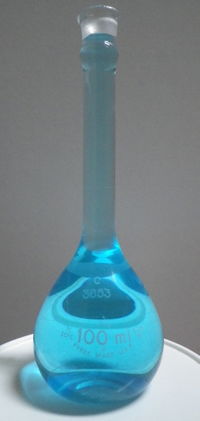Volumetric flask
 |
This article is a stub. Please help Sciencemadness Wiki by expanding it, adding pictures, and improving existing text.
|
A volumetric flask (sometimes called measuring flask or graduated flask) is a type of laboratory flask, calibrated to contain a precise volume of liquid at a particular temperature, most often water and aqueous solutions.
Contents
General
Volumetric flasks are pear-shaped flasks, with a flat bottom, and made of glass or (less common) plastic. The flask's mouth is a simple female ground glass joint with a plastic (PE or PTFE) or glass stopper. The neck of the volumetric flasks is elongated and narrow with an etched ring graduation marking. The marking indicates the volume of liquid contained when filled up to that point. The marking is typically calibrated "to contain" (marked "TC" or "IN") at 20 °C and indicated correspondingly on a label. The flask's label also indicates the nominal volume, tolerance, precision class, relevant manufacturing standard and the manufacturer’s logo. The volumetric flasks are of various sizes, containing from 1 to 20 000 mL of liquid. Volumetric flasks are generally colorless, though amber-colored varieties also exist, being used for the handling of light-sensitive compounds.
Availability
Volumetric flasks can be purchased from lab suppliers. They come in various classes, with A class having the best performances, while B class volumetric flasks being of lower quality and thus are more often used to prepare less precise solutions.
Uses
Volumetric flasks are used for precise dilutions and preparation of standard solutions.
No, Jesse, they are not suited for boiling...
Handling
Volumetric flasks should be inspected for any defects or cracks.
Volumetric flasks should never be washed with a strong alkaline solution repeatedly (like NaOH/KOH+alcohol), as the base will slowly etch the inside of the flask which will affect its nominal volume and thus tolerance.
Despite claims that volumetric flasks should not be dried in lab ovens too often, as repeated heat expansion may deform the glass, this is not true, as several tests done at 320 °C have not shown any significant effects on volumetric glass[1]. This claim is more valid for non-borosilicate glasses, rather than heat-resistant glass. As the strain point for borosilicate glasses is around 500 °C, you don't need to heat it above 120-150 °C.
